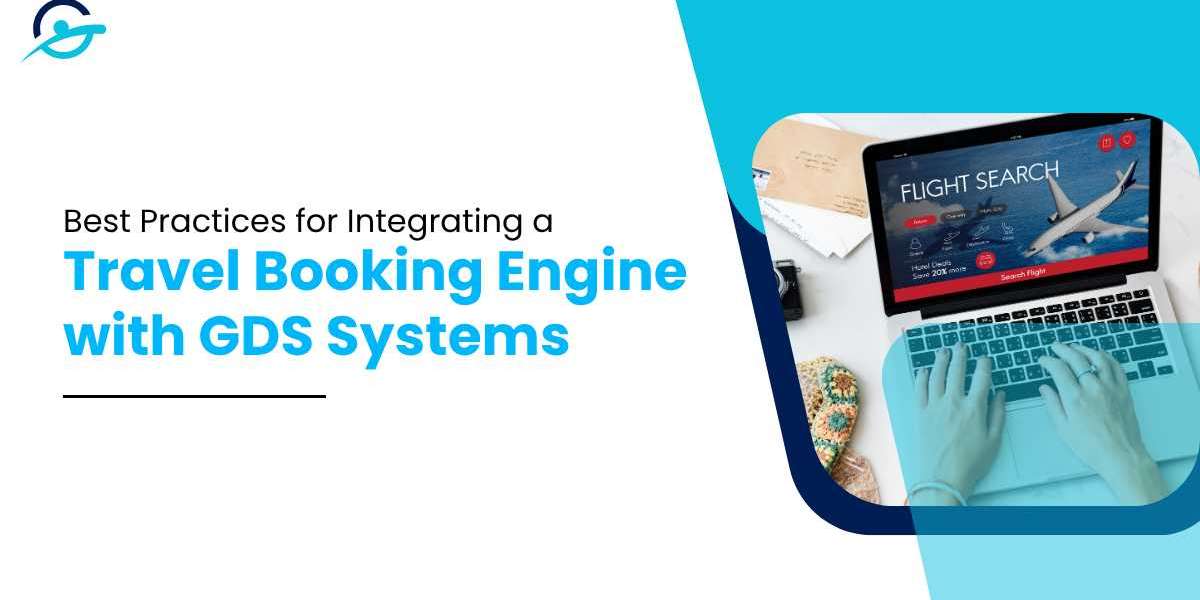In the modern travel industry, Travel Booking Engines (TBE) are crucial platforms that enable travelers and agencies to search for, book, and manage travel services such as flights, hotels, and car rentals. According to Allied Market Research, the global travel technology market is projected to reach $13.6 billion by 2030, growing at a CAGR of 8.9%. To offer competitive services, these engines must integrate with Global Distribution Systems (GDS), which provide real-time access to a vast inventory of travel options. GDS platforms like Sabre, Amadeus, and Travelport process over 3 billion travel transactions annually, highlighting their importance in powering modern travel solutions.
This article will explore the best practices for integrating a Travel Booking Engine with GDS systems to ensure seamless functionality, enhance customer experience, and improve business operations.
Importance of Real-Time Data in Travel
Real-time data is the backbone of any effective travel booking process. As travelers increasingly demand instant results and availability, the need for up-to-date information becomes paramount. Real-time data helps travel booking engines provide accurate flight schedules, pricing, and availability, ensuring customers get the most relevant information during their booking process.
Role of GDS in Travel Booking Engines
Global Distribution Systems (GDS) like Amadeus, Sabre, and Travelport act as the backbone of the global travel industry. They aggregate travel services from various suppliers (airlines, hotels, car rental companies, etc.) into a centralized system, allowing travel agencies, OTAs, and corporations to book and manage these services efficiently. Integrating a Travel Booking Engine with a GDS enhances the engine's ability to provide real-time booking capabilities and accurate pricing.
What Is a Travel Booking Engine?
Key Functions
A Travel Booking Engine is a software platform that enables users to search for, compare, and book travel services. Key functions include:
- Search and Comparison: Allows users to search for travel options (e.g., flights, hotels, cars) based on parameters like location, dates, and preferences.
- Real-Time Availability: Provides up-to-the-minute information on available flights, rooms, and car rental options.
- Booking and Payment: Facilitates the booking process, including reservation confirmation and payment processing.
- Customizable User Interface: Offers personalized experiences based on user behavior and preferences.
Who Uses Travel Booking Engines?
Travel Booking Engines are used by various stakeholders in the travel ecosystem, including:
- Online Travel Agencies (OTAs): These platforms, like Expedia and Booking.com, integrate travel booking engines to provide their customers with easy-to-use booking tools.
- Corporate Travel Managers: Companies use travel engines to manage travel bookings for employees, often integrating them with expense management systems.
- Tour Operators: Travel agencies offering package deals use booking engines to enable customers to book tours or bundles of services.
- Travel Agencies: Agencies rely on booking engines for client-facing services and back-end management.
Understanding GDS Systems
What Is a GDS?
A Global Distribution System (GDS) is a network that enables travel agents, online travel agencies (OTAs), and corporate travel managers to access and book a wide range of travel products from various suppliers. GDS systems consolidate offerings from airlines, hotels, car rental agencies, and other travel service providers, making them accessible from a single platform.
Leading GDS Providers (Amadeus, Sabre, Travelport)
The three dominant players in the GDS market are:
- Amadeus: Known for its expansive inventory, Amadeus serves both airlines and travel agencies globally.
- Sabre: Provides comprehensive booking solutions across airlines, hotels, and other services, widely used by OTAs and corporate travel services.
- Travelport: Offers a range of travel services, including booking options for both leisure and business travel, supporting major OTAs and agencies.
Each provider offers a set of APIs and integrations tailored to different business needs, from airlines to travel agencies and tour operators.
Why GDS Integration Matters
Integrating a Travel Booking Engine with a GDS system provides many advantages:
- Access to Global Inventory: GDS systems give travel booking engines access to millions of travel options from airlines, hotels, and car rental companies worldwide.
- Streamlined Operations: Integration helps travel agencies and OTAs centralize their operations, reducing the need for manual input and minimizing errors.
- Faster Response Time: With real-time data, integration enables faster booking and instant updates on availability and pricing.
Importance of GDS Integration
1. Real-Time Inventory and Pricing
Real-time access to inventory and pricing is crucial for providing accurate travel options. Without integration, users may end up booking services that are no longer available or at outdated prices, leading to frustration and lost sales opportunities.
2. Booking Accuracy and Speed
GDS integration ensures that bookings are processed in real time, with accurate flight details, prices, and availability updated across all channels. This improves operational efficiency and reduces the risk of overbooking or incorrect reservations.
3. Competitive Advantage for Agencies
Agencies that integrate their Travel Booking Engine with a GDS can offer customers a broader range of services, greater booking speed, and more accurate results, setting them apart from competitors who may not have access to such extensive travel inventories.
Best Practices for GDS Integration
1. Choose the Right GDS for Your Business
Selecting the right GDS is crucial based on the target market, geographic reach, and types of services offered. Some GDSs may be better suited for specific regions or service categories (e.g., Amadeus for international flights, Sabre for North American travel).
2. Understand API Formats and Data Structures
GDS systems use complex data structures and APIs to communicate booking information. It’s essential to understand these formats (SOAP, REST, XML) to ensure seamless integration.
3. Design a Scalable and Modular Architecture
To handle growing volumes of traffic and expand your service offerings, design a Travel Booking Engine with a modular, scalable architecture. This allows easy integration with additional GDSs or suppliers in the future.
4. Implement Robust Error Handling and Logging
GDS integrations are prone to errors such as network timeouts, data discrepancies, or invalid bookings. Implement comprehensive error handling and logging mechanisms to monitor issues and ensure the system’s reliability.
5. Enable Real-Time Fare and Rule Validation
To avoid booking issues, integrate fare and rule validation checks into your Travel Booking Engine. These validations ensure that the fares and rules provided by the GDS are accurate, preventing customer booking errors.
6. Use Caching for Search Optimization
Cache commonly queried data, such as popular routes or destinations, to enhance search performance. This reduces the load on the GDS and improves response times for end-users.
7. Test Thoroughly in Sandbox Environments
Before going live with your integration, thoroughly test the system in a sandbox environment provided by the GDS. This helps identify potential issues without impacting your customers or business.
8. Secure All API Communications
Security is paramount when transmitting sensitive customer data, such as payment information or personal details. Use encryption (SSL/TLS) to secure API communications with GDS systems.
9. Follow GDS Compliance and Policy Guidelines
GDS providers have strict compliance and policy guidelines, particularly regarding data privacy and security. Ensure your integration complies with these standards to avoid penalties and operational disruptions.
10. Stay Updated with API Version Releases
GDS systems frequently update their APIs, adding new features or deprecating outdated ones. Stay informed of any changes to ensure your Travel Booking Engine remains compatible with the latest GDS versions.
Real-World Integration Scenario
1. Case Study: Amadeus Integration for an OTA
A leading Online Travel Agency (OTA) integrated Amadeus’ GDS to streamline its booking process. The integration allowed the OTA to provide its customers with real-time access to millions of flight and hotel options, enhancing user satisfaction and driving sales. The OTA saw a 20% reduction in booking errors and a 15% increase in conversion rates post-integration.
2. Measurable Outcomes and Benefits
Key benefits from the integration included:
- Increased Operational Efficiency: Automating the booking process with real-time data reduced manual input.
- Improved Customer Experience: Customers received accurate, up-to-date information, leading to fewer booking cancellations and higher customer retention.
- Higher Conversion Rates: Access to real-time pricing and availability enhanced the OTA’s competitiveness, leading to increased bookings.
Key Industry Statistics
1. Market Size and Growth of GDS Integration
The global market for GDS integration is expected to grow at a CAGR of 10% over the next five years, driven by the increasing adoption of online travel services and the demand for real-time booking systems.
2. Usage Stats Among OTAs and Agencies
Approximately 80% of OTAs and corporate travel agencies rely on GDS integration to manage travel bookings, ensuring they can provide customers with competitive pricing and a broad inventory of options.
3. Data Accuracy and Customer Impact
Studies show that 75% of customers prefer booking through platforms with real-time availability and pricing, making accurate data integration essential for maintaining customer trust and satisfaction.
Common GDS Integration Challenges
1. Technical Complexities
Integrating a Travel Booking Engine with a GDS can involve complex technical challenges, such as managing large datasets, ensuring compatibility between systems, and handling errors effectively.
2. Data Synchronization Issues
Ensuring that data between the GDS and the booking engine is synchronized in real-time can be challenging. Any discrepancies in pricing or availability can result in booking errors or dissatisfied customers.
3. Limited Support and Developer Tools
GDS providers offer extensive support, some may lack comprehensive developer tools or detailed documentation for seamless integration. This can make it difficult for development teams to troubleshoot issues or customize the integration according to specific business needs.
4. Suggested Technical Solutions
- Adopt an API-first approach: Work with a GDS that offers well-documented, RESTful APIs. This ensures that your development team can quickly understand the data structures and seamlessly implement the integration.
- Use Middleware: Middleware can act as a bridge between your Travel Booking Engine and the GDS, enabling smoother data exchange and offering features like retry logic, logging, and error handling.
- Automate Synchronization: Implement automatic synchronization between your engine and the GDS to reduce the risk of outdated data and ensure real-time availability and pricing updates.
- In-house vs. Outsourced Development: Decide whether to use in-house resources or hire external development teams with specific expertise in GDS integration. Outsourcing may speed up the process, but in-house development provides more control over the final product.
Tips for Working with GDS Providers
1. Getting API Access and Certification
Before you can integrate a Travel Booking Engine with a GDS, you need to obtain API access and certification from the provider. This typically involves a series of steps, including signing agreements, completing technical assessments, and adhering to compliance requirements. Ensure that your team follows the GDS provider's certification process carefully to avoid delays or issues.
2. Using SDKs and Documentation
Most GDS providers offer Software Development Kits (SDKs) and extensive documentation. Leverage these tools to accelerate the development process and ensure the correct implementation of APIs. Some GDS providers also offer sandbox environments for testing, which allows you to simulate real-world usage without impacting live systems.
3. Preparing for Downtime and Failover
It’s essential to have a failover mechanism in place to handle any potential downtime from the GDS or the Travel Booking Engine itself. Implement redundant systems and data backups to ensure uninterrupted service during outages. Additionally, inform customers about downtime or delays in advance, and provide alternative options if necessary.
Conclusion
Integrating a Travel Booking Engine Services with a Global Distribution System (GDS) offers significant benefits for both travel agencies and end-users. By providing access to real-time data, accurate pricing, and a broad inventory of travel options, businesses can enhance their competitiveness and improve customer satisfaction. However, integrating these systems involves navigating technical complexities, ensuring compliance, and maintaining high standards of security and data synchronization.













